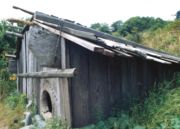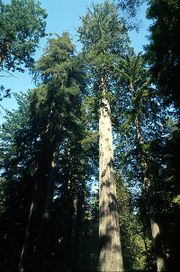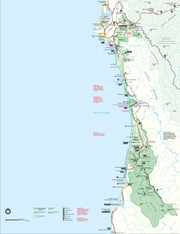Redwood National and State Parks
2008/9 Schools Wikipedia Selection. Related subjects: North American Geography
| Redwood National and State Parks | |||||||||||||||||||
|---|---|---|---|---|---|---|---|---|---|---|---|---|---|---|---|---|---|---|---|
| IUCN Category II ( National Park) | |||||||||||||||||||
| Location | Humboldt County & Del Norte County, California, USA | ||||||||||||||||||
| Nearest city | Crescent City | ||||||||||||||||||
| Coordinates | |||||||||||||||||||
| Area | 131,983 acres (534.12 km²) | ||||||||||||||||||
| Established | January 1, 1968 | ||||||||||||||||||
| Visitors | 391,282 (in 2004) | ||||||||||||||||||
| Governing body | Co-managed by US National Park Service and California Department of Parks and Recreation | ||||||||||||||||||
|
|||||||||||||||||||

The Redwood National and State Parks (RNSP) are located in the United States, along the coast of northern California. The parks consist of a combined area of 131,983 acres (534.12 km²) located entirely within Del Norte and Humboldt Counties and they protect 45% of all remaining Coastal Redwood (Sequoia sempervirens) old-growth forests, totaling at least 38,982 acres (157.75 km²). These trees are the tallest and one of the most massive tree species on Earth. In addition to the redwood forests, the parks preserve other indigenous flora, fauna, grassland prairie, cultural resources, portions of rivers and other streams, and 37 miles (60 km) of pristine coastline.
In 1850, old growth redwood forest covered more than 2,000,000 acres (8,100 km²) of the California coast. The northern portion of that area, originally inhabited by Native Americans, attracted many lumbermen and others turned gold miners when a minor gold rush brought them to the region. Failing in efforts to strike it rich in gold, these men turned toward harvesting the giant trees for booming development in San Francisco and other places on the West Coast. After many decades of unobstructed clear-cut logging, serious efforts toward conservation began. By the 1920s work of the Save-the-Redwoods League, founded in 1918 to preserve remaining old growth redwoods, eventually resulted in the establishment of Prairie Creek, Del Norte Coast, and Jedediah Smith Redwoods State Parks among others. Redwood National Park was created in 1968, by which time nearly 90% of the original redwood trees had been logged. The National Park Service (NPS) and the California Department of Parks and Recreation (CDPR) administratively combined Redwood National Park with the three abutting Redwood State Parks in 1994 for the purpose of cooperative forest management and stabilization of forests and watersheds as a single unit. This degree of collaboration between the National Park Service and a state park system is unique in the nation.
The ecosystem of the RNSP preserves a number of threatened animal species such as the Brown Pelican, Tidewater Goby, Bald Eagle, Chinook Salmon, Northern Spotted Owl, and Steller's Sea Lion. In recognition of the rare ecosystem and cultural history found in the parks, the United Nations designated them a World Heritage Site on September 5, 1980, and an International Biosphere Reserve on June 30, 1983.
History
As early as 3,000 years ago, Native Americans lived in the park area. Such groups as the Yurok, Tolowa, Shasta, Karok, Chilula, and Wiyot all have historical ties to the region. An 1852 census determined that the Yurok were the most numerous, with 55 villages and an estimated population of 2,500. They used the abundant redwood, which with its linear grain was easily split into planks, as a building material for boats, houses, and small villages. For buildings, the planks would be erected side by side in a narrow trench, with the upper portions bound with leather strapping and held by notches cut into the supporting roof beams. Redwood boards were used to form a shallow sloping roof.
Spanish, British, Russian, and American explorers visited the coast near the present park as early as the mid 16th century, to trade with local people for seal pelts. Until the arrival of Jedediah Smith, in 1828, no white explorer is known to have thoroughly investigated the inland region. The discovery of gold along Trinity Creek in 1850 brought thousands of miners into the area, which led to conflicts; the native peoples were forcibly removed and in some cases massacred. By 1895, only one third of the Yurok in one group of villages remained; and, by 1919, virtually all members of the Chilula tribe had either died or been assimilated into other tribes. The miners logged redwoods for building; and, when this minor gold rush ended, some of them became loggers, cutting down as many trees as they could sell. In 1850, 2,000,000 acres (8,100 km²) of the northwest California coast was old-growth redwood forest; but, by 1910, so many redwoods had been cut down that conservationists and concerned citizens began seeking ways to preserve the remaining trees. In 1911, U.S. Representative John E. Raker, of California, became the first politician to introduce legislation for the creation of a national park. However, no further action was taken by Congress at this time.
Frederick Russell Burnham was living on his 5,000-acre (20 km²) La Cuesta cattle ranch near the entrance to Sequoia Park when the completion of U.S. Route 101 brought fellow conservationists John C. Merriam, Madison Grant, and Henry Fairfield Osborn to the region. Disappointed to find that there were no public lands set aside to preserve the redwoods, these four early conservationists founded the Save-the-Redwoods League in 1918. Using matching funds provided by the state of California, the Save-the-Redwoods League managed to save areas of concentrated or multiple redwood groves or entire forests by the early 1920s. When California created a state park system, in 1927, Burnham joined as a founding member of the commission and three of the redwood areas became the Prairie Creek Redwoods, Del Norte Coast Redwoods, and Jedediah Smith Redwoods State Parks. A fourth became Humboldt Redwoods State Park, by far the largest of the individual Redwood State Parks, but not in the Redwood National and State Park system. Because of the high demand for lumber during World War II and the construction boom of the 1950s, the creation of a national park was delayed. Efforts by the Save-the-Redwoods League, the Sierra Club, and the National Geographic Society to create a national park began in the early 1960s. After intense lobbying of Congress, the bill creating Redwood National Park was signed by President Lyndon Johnson on 2 October 1968. The Save-the-Redwoods League and other entities purchased over 100,000 acres (400 km²), which were added to existing state parks. In 1978, 48,000 acres (190 km²) were added to Redwood National Park in a major expansion. However, only a fifth of that land was old-growth forest, the rest having been logged. This expansion protected the watershed along Redwood Creek from being adversely affected by logging operations outside the park. The federal and state parks were administratively combined in 1994.
The United Nations designated Redwood National and State Parks a World Heritage Site on 5 September 1980. The evaluation committee noted 50 prehistoric archaeological sites, spanning 4,500 years. It also cited ongoing research in the park by Humboldt State University researchers, among others. The park is part of a much larger region designated the California Coast Ranges International Biosphere Reserve on June 30, 1983. The California Coast Ranges biosphere is overseen by the University of California Natural Reserve System.
Park management
The RNSP are cooperatively managed by the National Park Service, a federal agency within the U.S. Department of the Interior, and the California Department of Parks and Recreation. The National Park annual budget of $7,380,000 in 2004 was decreased to $7,251,000 in 2005 (a reduction of nearly 2%). This amount supports all operations, including 102 permanent and 70 temporary staff. The combined budget for the three State Parks of $1,096,248 covered 17 permanent and 30 temporary staff in 2003. The two agencies work cooperatively to protect the redwoods, the pristine Pacific Ocean coastline, the cultural resources, and the unique natural habitat. The land that was added to the parks in 1978 had previously been logged, and efforts to restore these areas have been ongoing for decades, with old logging roads being removed and the land allowed to return to its original state. Lack of funding has precluded major improvements, however, and timber companies have replanted much of the logged area with non-native tree species. Coastline areas, including dunes and coastal prairie, have been invaded by exotic species, partly due to the suppression of forest fires until the 1980s. A fire management plan now allows controlled burning as one method to return the parkland to its original state. Since the redwoods were logged on the basis of accessibility, with inaccessible areas being cut last, large old growth forest sections were isolated from one another, sometimes by many miles. In these cases it will be decades more before mature forest can return, regardless of the amount of money used to rehabilitate the ecosystem.
The park has transformed a few logging roads into scenic public drives. These do not meet current safety standards, but funding to improve them is not available at present. Park structures such as visitor centers and employee housing also need updating to meet increasing demands. The park employees perform air and water quality surveys, monitor endangered and threatened species, and work closely with the California Coastal National Monument, which is managed by the U.S. Bureau of Land Management. The park headquarters is in Crescent City, California.
Recreation
Other than the DeMartin Redwood Youth Hostel, a low-amenities shared lodging facility (near Klamath), there are no hotels or motels within the parks boundaries. However, nearby towns provide small hotels and inns, with extensive lodging options available in the regional trading centers of Crescent City on the northern end of the park and Arcata and Eureka located to the south. The park is 340 miles (550 km) north of San Francisco, California, and 330 miles (530 km) south of Portland, Oregon, and U.S. Route 101 passes through it from north to south. The Smith River National Recreation Area, part of the Six Rivers National Forest, is adjacent to the north end of RNSP.
While the state parks have front country campsites that can be driven to, the federal sections of the park do not, and hiking is the only way of reaching back country campsites. These are at Mill Creek campground in Del Norte Coast Redwoods State Park and Jedediah Smith campground in Jedediah Smith Redwoods State Park, which together have 251 campsites, the Elk Prairie campground in Prairie Creek Redwoods State Park which has 75, and the Gold Bluffs Beach campground which has 25 campsites. Other nearby state parks have additional front country camping. Back country camping is by permit only and is only allowed in designated sites, except on gravel bars along Redwood Creek.
The back country is highly regulated to prevent overuse and to permit as many groups as possible to explore the forest. Camping in the back country is therefore limited to five consecutive nights, and 15 nights in any one year. Proper food storage to minimize encounters with bears is strongly enforced, and hikers and backpackers are required to take out any trash they generate.
Almost 200 miles (320 km) of hiking trails exist in the parks, but during the rainy season some temporary footbridges are removed, as they would be destroyed by high streams. Throughout the year, trails are often wet and hikers need to be well prepared for rainy weather and consult information centers for updates on trail conditions.
Horseback riding and mountain biking are popular but are only allowed on certain trails. Kayaking is popular along the seacoast and in the various rivers and streams. Kayakers and canoeists frequently travel the Smith River, which is the longest undammed river remaining in California. Fishing for salmon and steelhead, a highly prized anadromous form of rainbow trout over 16 inches (41 cm), is best in the Smith and Klamath rivers. A California sport fishing license is required to fish any of the rivers and streams. Hunting is not permitted anywhere in the parks, but is allowed in nearby National Forests.
The park has two visitor centers and three additional information points. At the visitor centers, guided nature walks and general information is available. Each campground offers campfire talks during the summer months as well as guided tours. The parks have many picnic areas, which are all easily accessed by vehicle.
In films
The park has served as location shots for numerous films. The Endor scenes for the Star Wars film, Return of the Jedi (Episode VI) were filmed in the Tall Trees Redwood Grove in the northern part of Humboldt County. Scenes for The Lost World: Jurassic Park as well as the movie Outbreak, were filmed at the nearby Prairie Creek Redwoods State Park and at Patrick's Point State Park. The films The Big Trees and Valley of the Giants were also filmed here, near Orick. The film E.T., was filmed in the Del Norte Coast Redwoods State Park.


